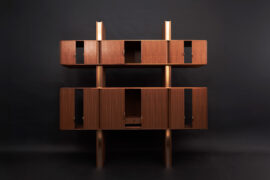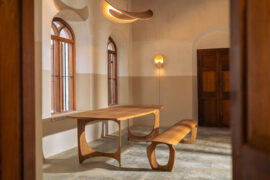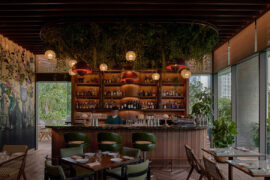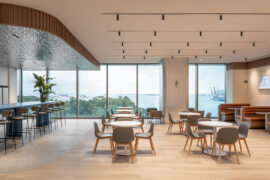With a focus on selective usage and natural regeneration, hardwood forests in the US are being managed sustainably. See how this combines with the knowledge of designers to make timber a sustainable and sophisticated choice.
November 17th, 2022
Wood is a material best understood through the dimension of time. Not only the time it takes for a forest to grow, and the history contained within one tree, but the lifetime of expertise developed by those who manage the forests and the designers who understand the value of quality material. Two fundamentals ensure successful timber design: a reliable and sustainable source of a supply and understanding of how to create with natural materials.
Sydney-based furniture designer Tom Fereday speaks of his work being “material-driven” and the importance of “celebrating the beauty of natural material.” Each piece has its own qualities so the task of the designer becomes one of working with the material rather than over-working it and exposing the character of the timber.
As AHEC regional director Roderick Wiles explains, as a natural material, wood has a huge amount of natural variation. However designers should not be daunted, as one of the roles of organisations such as AHEC, is to support designers in their understanding of the qualities and capabilities of different species, allowing them to work with confidence.
Perhaps most importantly, if selected with some understanding of source, designers can be certain that they are acting responsibly with regards to minimising the environmental impact of their design.
In the hardwood forests of the US, approximately three-quarters of the resource is owned by private individuals. Wiles describes how the owners “understand the value of the forest and want to look after it for future generations.”
They allow their trees to grow for longer and selectively harvest only a few trees per hectare. This practice promotes new growth through natural regeneration and this growth outstrips harvest. This means that the US forest is a resource that is increasing in volume every year. This is quite different from many forestry practices around the world.
With a combination of certainty of environmental impact and the vast range of quality species from which to choose, it is clear why American hardwoods are the go-to choice for a designer of Fereday’s calibre.
INDESIGN is on instagram
Follow @indesignlive
A searchable and comprehensive guide for specifying leading products and their suppliers
Keep up to date with the latest and greatest from our industry BFF's!

London-based design duo Raw Edges have joined forces with Established & Sons and Tongue & Groove to introduce Wall to Wall – a hand-stained, “living collection” that transforms parquet flooring into a canvas of colour, pattern, and possibility.
The new range features slabs with warm, earthy palettes that lend a sense of organic luxury to every space.

For Aidan Mawhinney, the secret ingredient to Living Edge’s success “comes down to people, product and place.” As the brand celebrates a significant 25-year milestone, it’s that commitment to authentic, sustainable design – and the people behind it all – that continues to anchor its legacy.

Adam Markowitz Design, in collaboration with Simeon Dux, has been awarded The Object at the INDE.Awards 2025. Their winning project, A Cabinet of Curiosities, is a masterwork of craftsmanship and adaptability; a poetic response to shifting domestic and professional life in the post-COVID era.

From Australian architects to Spanish and Indian designers, Design Mumbai 2025 expands its international reach — proving India’s growing role on the global design stage.

Grounded by the rich warmth of American white oak, The Standard’s newly opened restaurant, Kaya, redefines the classic dining convention through a tasteful fusion of biophilic design, mid-century modern sensibility and elevated whimsy.
The internet never sleeps! Here's the stuff you might have missed

Continually making its presence felt on the architecture and design scene, DKO has seen a plethora of promotions across its studios in mid-year.

Bean Buro’s Singapore office for Anglo-Eastern is a poetic continuation of their Hong Kong headquarters — a workplace that balances identity and calm.